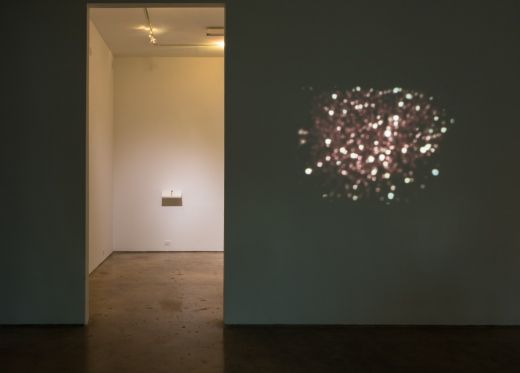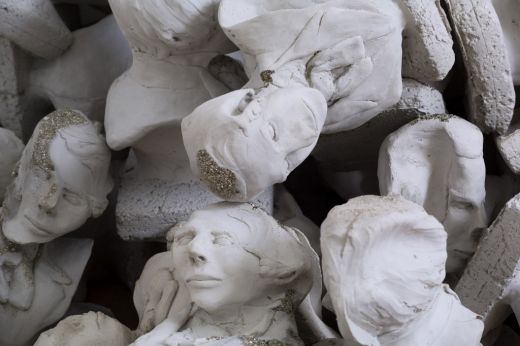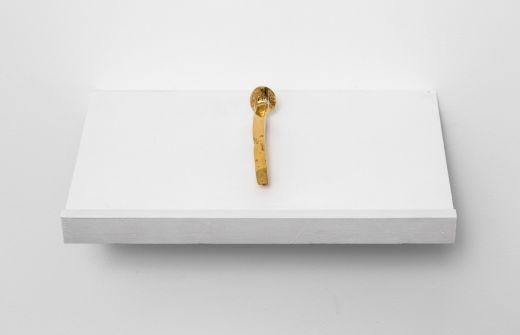
Installation view. Photo Courtesy of Emerson Dorsch.
Emerson Dorsch
May 17 – July 31, 2014
Thanks to growing up in Britain, my knowledge of the American West is largely based on The Lone Ranger television show and John Wayne movies. Luckily, these unimpressive credentials did not impede my ability to make sense of, and appreciate, Cara Despain’s exhibition Cast Set, presented in the project room at Emerson Dorsch.
Like most viewers, I was able to access the popular tropes associated with the American West utilized by Despain, which the gallery text describes as being “embedded in our collective psyche.” The idea of a collective psyche strikes me as somewhat suspect, since it assumes a degree of exposure to Western culture (in the global sense) that is by no means universal.

Cara Despain, Claims(detail), 2014. Ongoing edition of unique busts from a single mold. Cast concrete, pyrite ore, dimensions variable.
Nevertheless, Despain provides numerous cues that enable viewers to quickly tune in to the tenor of the work, even if fuller comprehension may only be accessible to those with a greater breadth of knowledge. Because Despain draws upon familiar ideas and traditional iconography related to the American West, her work often elicits a sense of romantic nostalgia. For example, a 24-carat-gold railroad spike, referencing those cast to mark completion of the Transcontinental Railroad in 1869, seems symbolic of the hopes of those who journeyed West. However, each of these points of seeming recognition are curiously skewed. The show is soundtracked by a slowed-down recording of “Oh My Darling, Clementine,” creating a dirge like background against which to view the other works. It seems impossible not to dwell upon the line “you are lost and gone forever.”
“Sun, Set” is similarly complex. Stop-animated saloon doors smoothly swing open and closed, revealing a gaudy sunset juxtaposed with a digital slideshow (each new slide accompanied by a nostalgic ‘click’) that creates a multi-layered image of sublime/lurid Western landscape views—mountains, rock formations, churches and yet more sunsets. Nostalgia is also present in “Repose.” Digitally projected onto the project room’s exterior wall, but originally filmed on Super 8, with an accompanying of antiquated clicks and pops of light, the film depicts grains of a glimmering golden substance being shaken from side to side as though by a lazy prospector, eventually blurring into hexagons of light.

Single Unified Artifact, 2013. Railroad spike, 24kt gold. 1″x1″6″
Underlying this tempered romanticism and nostalgia is Utah-born, Miami-based Despain’s status as a descendent of Mormon pioneers; a significant heritage for those keen to access a deeper understanding of her work. Not explicitly referenced—although a careful viewer will note the frequent mentions of Utah—Mormonism and its integral link to the West is a crucial presence.
Indeed, a heap of cast concrete busts of a 19th-century gentleman are based on Despain’s interpretation of official portraits of Joseph Smith, founder of the Latter Day Saint Movement. Every bust (with the exception of one standing upright nearby) has been modified by manipulating the mold, and each features a glittering deposit of pyrite, popularly known as Fool’s Gold—gold, but not gold. Despain has created a fond, rich, challenging simulacra of an idea of place: this is the West, but not the West.










